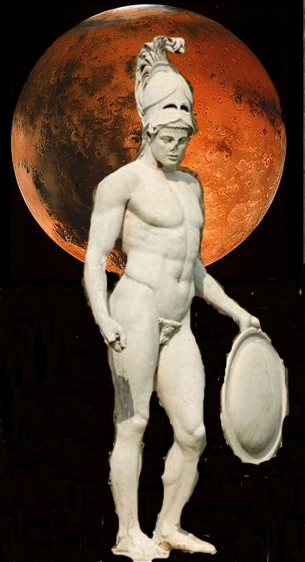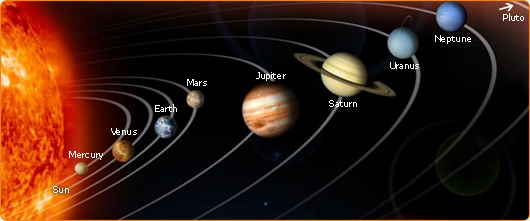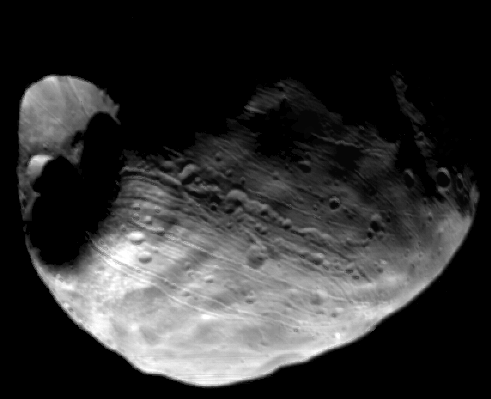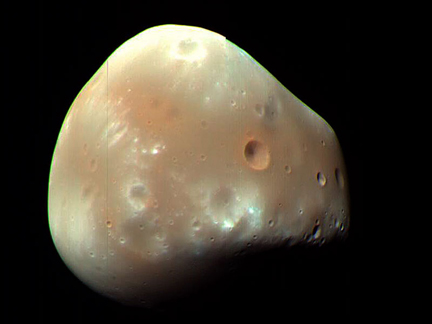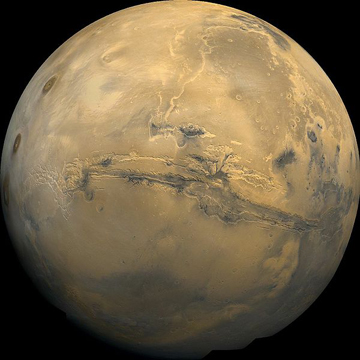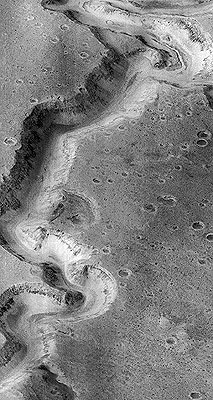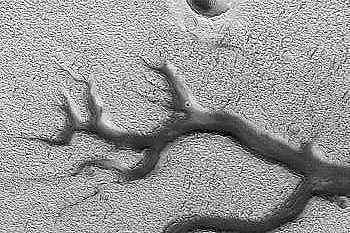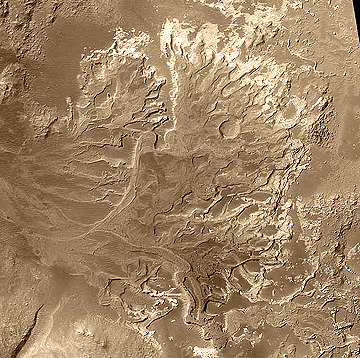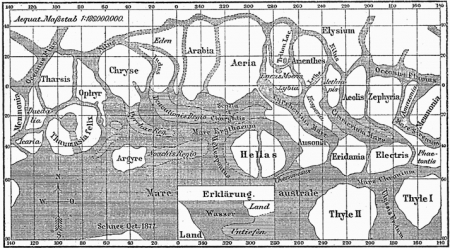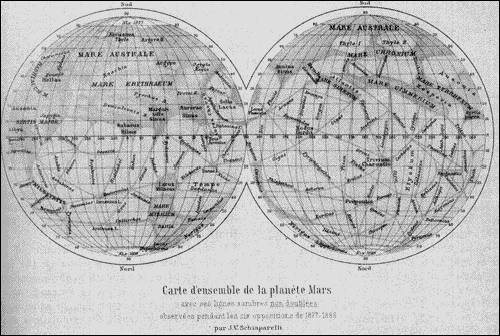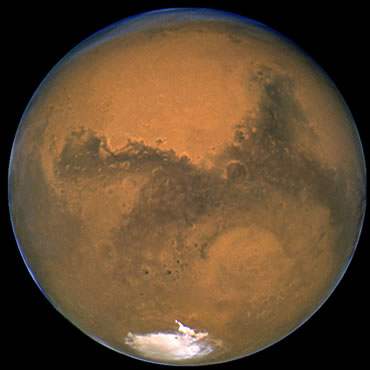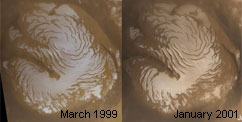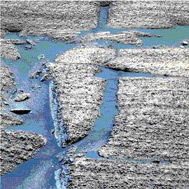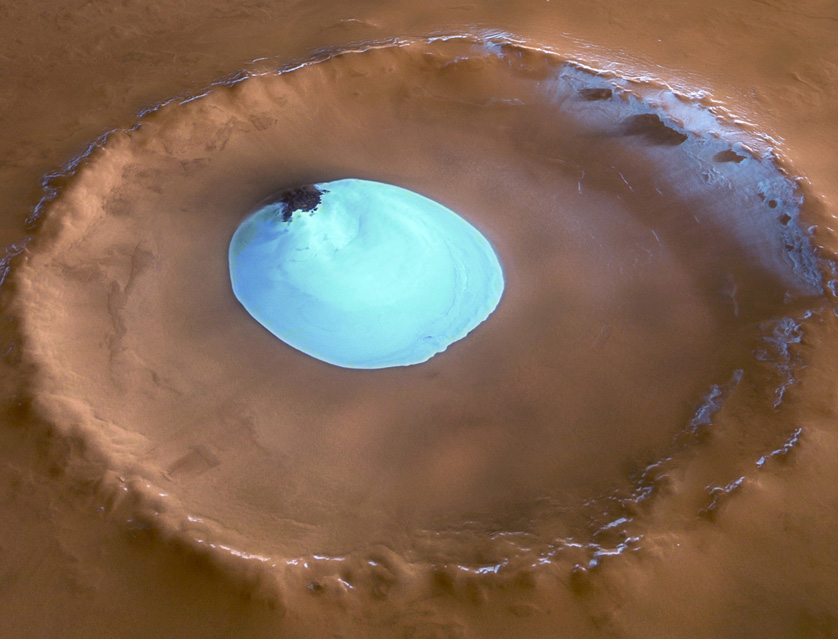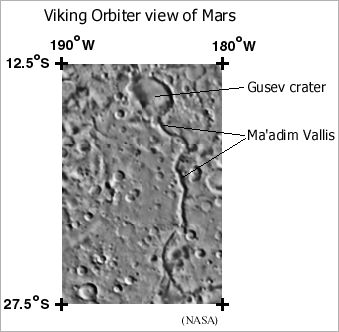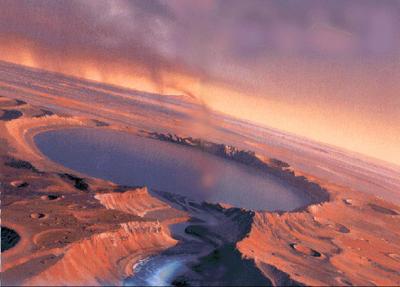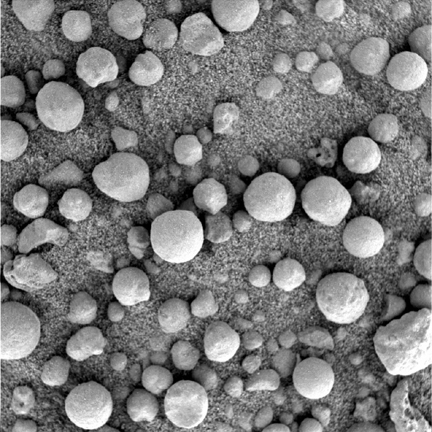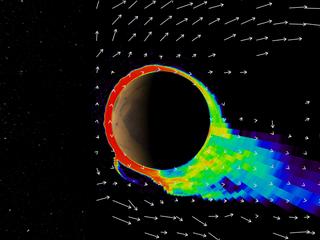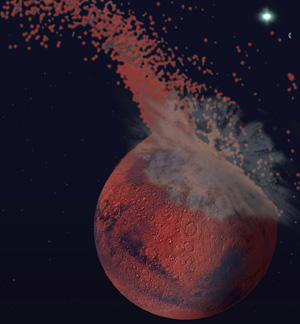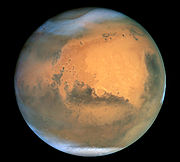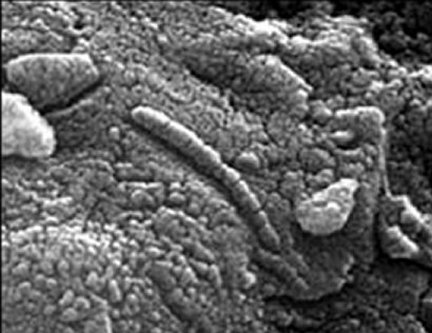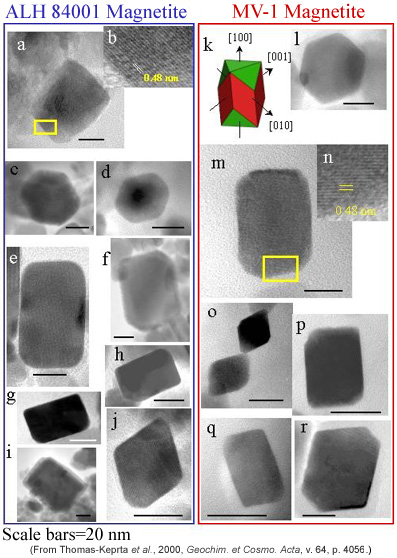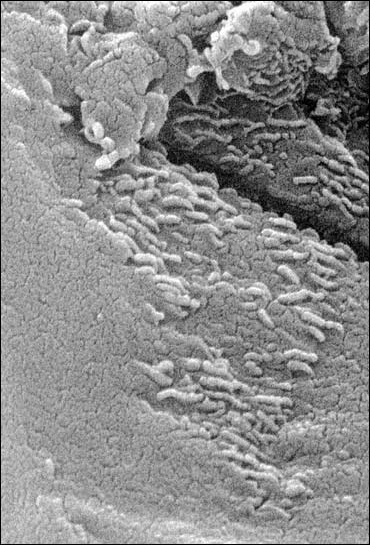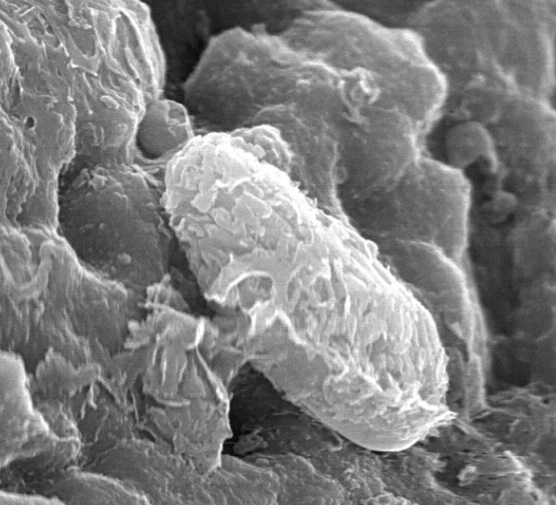|
|
|
|
|
|
|
|
Chapter 3. Life On Mars. |
| Red Planet - God of War The Myths, History & Discovery of Life on the Red Planet “Ares, Ares, bane of men, blood-stained stormer of cities..." --Phoebus Apollo, the Iliad.
Ares, the Red Planet and God of War PLANETARY CREATION MYTHS FROM ANCIENT GREECE - ROME For thousands of years humans have gazed with wonder upon the blood red planet, known today and among the ancient Romans as "Mars." The Romans inherited much of their knowledge of astronomy from the Greeks. Both the ancient Greeks and Romans recognized five 'wandering stars' (Greek: plantai): Mercury, Venus (Aphrodite in Greek), Jupiter (Zeus in Greek), Saturn, and Mars (Ares in Greek). Of all the planets, only the blood red surface of Mars could be seen with the naked eye, and the ancients associated the red planet with death and war. Thus, originally, these ancient gods were not humans, but planets, with yet other gods representing the Sun (Apollo), the Earth (Gai) and the cosmos (Ouranos).
The ancient sages used allegory and metaphor when describing their discoveries of the heavens, for the common folk and even kings and queens were not to be made privy to these cosmic secrets. Ouranos, they explained, ruled the universe during a period of great chaos before the beginning of time. Ouranos (also known as Uranus and Olympus) was primordial (protogenos), and had no parentage.
Stars live and die, even in an orderly universe and Ouranos (Uranus) was overthrown by Cronus (Saturn) who cut off his genitals and cast the severed member into the sea. From the blood that spilled out from Ouranos the Gigantes, Erinyes, and Meliae were produced.
Cronus sired many gods but swallowed them as they were born, which was the intended fate of the planet Jupiter, known as Zeus. But Cronus swallowed a giant stone instead and was split open, releasing all the gods and goddesses which became the planets of our solar system. As restated in the Iliad, Ouranos-and-Olympus was now ruled by Zeus: "Thus, all the gods, which include the planets, the sun, and the constellations, dwell within Olympus which is Ouranos, the heavens." Therefore, our solar system was first ruled by Uranus, then Saturn, and finally Jupiter, the King of the Gods.
MARS: THE GOD OF WAR
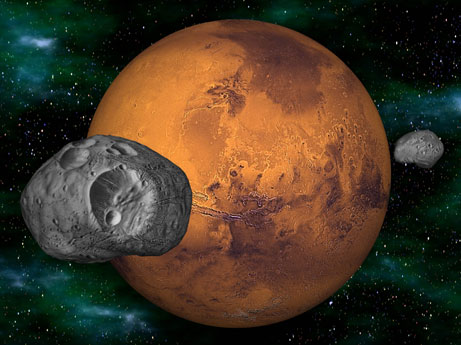
Mars was feared, hated, and honored by the ancients, but was generally revered and initially rivaled Jupiter as the most honoured of the planetary gods. He was regarded as the father of Rome's founder, Romulus, and the Romans believed that all Romans were descendants of Mars. Thus, Mars became the tutelary god of the city of Rome.
However, the ancients believed that even with the establishment of these planetary gods, there was great chaos within the heavens. According to legend and the fragmentry remains of this ancient cosmology, Jupiter, the king of the planets had a consort, Metis, who was also a Titan and planetary god. But Metis was swallowed up by this gas giant, and in consequence, Athena burst burst forth from Jupiter's head fully armed with weapons of war and cosmic symbols on her breast and lance. The great serpent was her symbol, a giant serpent which coils and snakes through the heavens waging war.
Thus, there was strife among the gods. and Venus and Mars, who were sister and brother and the most beautiful of the planets, loved together in defiance of the laws and the wishes of the other gods.
In a tale retold in Homer's Oliad, Mars and Venus were causing strife among the people's of Earth, in defiance of the gods, and they were attacked by Athena who first wounded Venus in the wrist, and struck Mars with a titanic boulder knocking him senseless.
Athena put on the Helm of Death so that blood stained Ares could not see her coming and caused Ares such a horrible wound that he bellowed like nine thousand men in a voice so loud it could be heard by the people of the Earth. Then Ares darkened the skies as he ascended to heaven... but not befor Athena had stripped him of his helmet and shield.
And what is the helmet and shield of a planet?
THE CANALS OF MARS
For the first billion years after it was formed, Mars, may have been covered by a thick blanket of carbon dioxide, which created a greenhouse effect that warmed the planet. Likewise, during this period Mars may have been covered with oceans, lakes and streams. And then, around 4 billion years ago, Mars was struck a mighty blow.
Martian River Channels and tributaries When telescopes began to spy on Mars, scientists believed they might be looking at artifiically created canals fashioned by engineers. The illussion of water ways were first observed by the Italian astronomer Giovanni Schiaparelli during the opposition of 1877, and confirmed by later observers. Schiaparelli called these canali, which was translated into English as "canals."
Schiaparelli's drawings of Martian canali Changes in the coloration of Mars made many wonder if vegatation was growing then retreating according to the seasons. Others wondered if there were a link between these changing colorations and the canals.
Schiaparelli's drawings of Martian canali
Percival Lowell read about Schiaparelli's canali. Lowell also knew there was speculation about Martian vegetation, and he became fascinated by the possibility of life on Mars. Lowell was a wealthy businessman, and although he had no formal training in astronomy he had the funds to build an observatory, and did so on a moutain near Flagstaff, Arizona, the Lowell Observatory. Lowell devoted the rest of his life to studying Mars and drew very detailed maps of his observations.
PLowell was convinced that Mars was a dying world whose inhabitants built a planet wide system of canals to transport water from the polar icecaps to the warmer equatorial regions where advance civilizations had erected great cities. Although many scientists disputed his conclusions, Lowell's ideas captured the public imagination.
Alfred Russel Wallace was a well known scientist whose theories of "natural selection" had been plagierized by Darwin. Wallace disputed Lowell's claims in a scientiific treatise he published in 1907, Is Mars Habitable? Wallace analysed all available data and demonstrated that the surface of Mars was much colder than Lowell had estimated. Further, the atmospheric pressure was too low for liquid water to exist on the surface. Wallace also reported that efforts to find evidence of water vapor in the Martian atmosphere with spectroscopic analysis had failed. He concluded that complex life on Mars was impossible, let alone the planet -wide irrigation system championed by Lowell.
Wallace's analysis proved correct. In 1965, Mariner 4 took the first close up pictures of Mars revealing numerous impact craters and a generally barren landscape devoid of any semblance of canals. However, the planet was not without water.
WATER DISCOVERED ON MARS
Photographs taken by Mariner 9 provided considerable evidence that water had flowed across the surface of the Red Planet. Moreover, the polar ice caps were growing and shrinking accrding ot the seasons, suggesting they contained frozen seas. Clouds were spied drifting across the Martians skies; clouds that might contain water.
It has long been believed that the planet's polar caps contain frozen water. Astonomers have suspected as much since the 1800s. This has since been confirmed based on direct and indirect methods such as analysis of temperature data or the detection of traces of hydrogen. In 2001, NASA's Mars Odyssey spacecraft discovered vast amounts of frozen water in the northern and southern latitudes, and lots of ice mixed with the soil.
In 2004 Europe's Mars orbiter also found water ice on the Red Planet's surface. The discovery was based on analysis of vapors of water molecules detected by the infrared camera aboard the Mars Express spacecraft which was circling the Red Planet's south pole.
Orbiting spacecraft have also photographed what appear to be dry lake beds and sinuous channels, ancient coastlines and other landscapes that could have been shaped by oceans of running water and the meandering flow of rivers.
Frozen lakes of water discovered by The European Space Agency Mars orbiter In 2006, NASA sent twin rovers to opposite sides of Mars. The Spirit, rover set down in Gusev Crater a four-billion-year-old crater the size of Connecticut which is littered with rocks of all sizes. A channel cuts through the crater. Long ago this channel may have been a river which dumped water and sediments into what could have been a lake formed by Gusav Crater.
The Opportunity rover landed at Meridiani Planum, which is flat, almost featureless, and blanketed with a fine-grained red soil and dark pebbles. Meridiani Planum also contains gray hematite, an iron oxide mineral that is typically, formed in the presence of water. The Opportunity overshot its target, landing in a shallow 72-foot-wide crater near an outcrop of finely layered bedrock 25 feet away. Measuments of thermal emissions identified an iron oxide on the surface of the bedrock. On Earth iron oxide typically forms in the presence of water.
Meridiani Planum outcrop rocks on the margins of “Erebus Crater” displaying well-preserved, fine-scale layering cross-laminations and ripples normally created by water. Opportunity also found a high concentration of sulfur with its X- ray Moessbauer spectrometer, including a hydrated iron-sulfate mineral called jarosite. The presence of jarosite suggests that the outcrop may have been part of an acidic lake or hot springs. Likewise, the Mars rover, Spirit dug up additional evidence of water, i.e. the residue of sulfur and magnesium in a trench it had dug in the Gusev Crater. On Earth a microbe known as desulfotomaculum, uses sulfur as its energy source. It can form spores, become dormant, and hibernate depending on changes in the Martian environment. Thus, sulphur eating microbes could well continue to flourish deep beneath the Martian soil. The Opportunity also discovered an astounding amount of salt within the rocks, which could only be the residue of an ancient salt water lake or sea. Apparently the rocky outcrop and surrounding area was once the shoreline of a salty sea, perhaps surrounded by hot springs. On Earth, innumerable microbes thrive in salty environments, inlcuding halophiles which are represented in all three primary domains of life -- Bacteria, Eukarya and Archaea. And not just miucrobes, but animals such as shrimp. That suggests the genes responsible for these traits which make it possible to thrive in salt, appeared in multiple domains of life--and this would be possible if these genes were inherited. Salt also lowers the freezing temperature of water. The average global temperature on Mars, is minus 63 degrees Fahrenheit (-53 C). Salt water beneath the surface, would not only be warmer, but remain in liquid form even at temperatures below freezing. Further, even as concentration of salt grow larger as the water boiled away, turned to mist or sank beneath the surface, innumerable creatures could flourish within the increasing briny water. Thus, even on modern day Mars, complex life may flourish beneth the surface. In fact, the current atmosphere of Mars is comparable to the Earth 3.7 million years ago. (M. Lammer et al.,m Martian atmospheric Evolution. In G. Horneck & C. Baumstark-Khan. Astrobiology, Springer, 2002).; a time period during which single celled prokaryote life on Earth had already become well established. In fact, by 3,8 BYA complex eukaryotic life, had left their fossilized photosynthesizing signatures in Earthly rocks.
Microscopic image of HematiteSpheres as seen by the Opportunity rover.
The Opportunity also photographed small round specimens, which some believe to be hematite, an oxide of iron. Hematite is produced biologically. On earth, hematite is a waste product produced by a common species of bacteria, shewanella. In the absence of oxygen shewanella metabolizes minerals such as iron, and excretes hematite. When exposed to large amounts of water, a spherical ball begins to form and pops out onto the surface after considerable water erosion. However, these round Martian specimens were found not only on the crater floor, which may have once been filled with water, but on the soil above the outcrop of the crater. Unless these balls rolled up hills, this indicates a biological source. The only other creatures on Earth which creates similar spherical balls are known as "puff balls." Here are some examples of Martian puff balls and Martian mushrooms:

 Thus it is now apparent that Mars had been a very wet planet, which long ago was criss crossed with oceans, lakes, rivers and streams. And where there is water, there is life.
ANCIENT MARS WAS A WET PLANET Mars, in fact, at one time in its ancient past, had all the necessities for the evolution and metamorphosis of complex multi-cellular life. This includes water and an atmosphere which may have contained high concentrations of carbon dioxide and some oxygen. The atmospheres of Mars would have provided a heat-trapping greenhouse cover and shield the planet from deadly UV rays. Like the Earth, Mars was created from the debris and shattered planet that had orbited the parent Star. Both planets underwent a heavy bombardment by meteors, asteroids,and comets, for the first 700 million years after they were first formed. Thus like the Earth, Mars must have been repeatedly contaminated with alien life embedded in that debris. However, unlike the Earth, Mars is a much smaller target, being only half as wide and with only one-tenth its mass. Thus, the consequences of this bombardment may have been much less destructive--at least until struck by that planet-side body around 4 billion years ago which may have stripped Mars of its atmospheric shield. Plate tectonics appears to have been absent on Mars, creating a different type of atmospheric chemistry as compared to the Earth which was initially belching forth toxic gasses. Also, being smaller in size, oxygen and other gasses excreted by microbes and photosynthesizing creatures, would have more quickly flooded and made up a greater proportion of the Martian atmosphere, thus creating a life sustaining environment for complex creatures, at a much earlier age than the Earth which was constantly belching forth toxic gasses. WHAT BECAME OF THE MARTIAN ATMOSPHERE & MAGNETIC FIELD? When Mars was young it also had a protective magnetosphere which protected the planet and its atmosphere from the sun's solar winds. This enabled its biologically produced atmosphere to remain tethered to the planet. The presence of an ancient magnetosphere was confirmed in 1997, when the Mars Global Surveyor, detected surface magnetic anomalies indicting the existence of a strong ancient Martian magnetic field. Scientists determined that the original magnetic field of Mars may have been anywhere from-10% to 100% of modern Earth. The magnetic field would have made it possible for complex creatures to take root and flourish on Mars. On Earth the magnetic field creates a magnetosphere which protects the planet from the sun's solar winds which are sufficiently powerful that they can blow away a planet's atmosphere. Thus, because Mars had a magnetic field, the sun's solar winds would have been blocked and its atmosphere would have remained bound to the planet. Being so much smaller than the Earth, Mars would have more quickly developed and maintained a biologically produced atmosphere that would enable even more complex life forms to diversify.
The Earth's Magnetic Field
Mars Lost its Magnetic Field However, the Martian magnetic field disappeared around between 3.9 to 3.7 billion years ago. And then the planet began to die. MARS STRUCK BY A MOON-SIZED ASTEROID Mars was repeatedly traumatized by bombardments of meteors, asteroids, and comets during its early history. Like the Earth, Uranus, and Mercury, around 4 billion years ago Mars was also struck by a planet-sized wayward world, possibly by a rogue planet that had been expelled from the solar system of the parent star prior to supernova. It is this cosmic catastrophe, this titanic collision which may have irrevocably altered the planet's magnetic field and magnetosphere --and with the loss of this protective shield, Mars also lost its oceans and atmosphere and became a cold and desolate world.
The collision may have been a catastrophe for any complex life forms which had taken root on the planet. It is possibly this impact which nearly eliminated the Martian magnetic field allowing the sun's solar winds to strip away its atmosphere, taking with it water molecules and thus oceans of water. Because Mars now has an exceedingly week magnetic field, its atmospheres continually bleed away into space. Likewise, when that titanic object or objects struck Mars, some of its oceans may have been vaporized. Other bodies of water would begin to boil off with the loss of its atmosphere which protected the planet from the full force of the sun's UV rays, like a helmet. Much of the planet's water began to disappear. Thus, by 3,5 billion years ago, its magnetic field had almost completely disappeared, the planet was bathed in UV rays, its oceans, lakes, and streams had evaporated, froze, or seeped beneath the ground, and its oxygen and carbon dioxide atmosphere was absorbed into rocks or sucked into space propelled by the sun's solar winds. Mars became cold, with whatever water remaining at ground level turning to permafrost or disappearing into the depths of the red planet. The planet became so hostile to complex life, that it would have most likely completely died out. However, that does not mean that Mars today, is lifeless. In fact, the current atmosphere of Mars is comparable to the Earth 3.7 million years ago. (M. Lammer et al.,m Martian atmospheric Evolution. In G. Horneck & C. Baumstark-Khan. Astrobiology, Springer, 2002).; a time period during which single celled prokaryote and even more complex eukaryotic life on Earth had already become well established. In fact, by 3,8 BYA complex eukaryotic life, had left their fossilized photosynthesizing signatures in Earthly rocks. This means, complex single celled microbial life may still flourish on the red planet. LIFE FROM MARS: MARTIAN METEORITE ALH 84001 Where there is water,there is life, and Mars was certainly flush with microbial life for the first several hundred millions years after its formation. We know this with certainty, because mineralized, fossilized impressions of Martian microbes have been transported to Earth.
Nearly 4 billion years would pass, and then, 16 million years ago, an asteroid or comet slammed into Mars with the explosive energy of a million nuclear bombs. The impact blasted chunks of Mars into space, which were ejected at 11,000 mph. One of those rocks was 4 billion years old. Its cargo? Fossilized Martian microbes.
There it lay, exposed to the elements and those microbes which thrive in the frozen wastes. And then, one sunny afternoon, on December 27, 1984, it was discovered, peeping out from beneath the snow, in a desolate region know as the Far Western Ice field, adjacent to a ridge of rocks named Allan Hills. Bobbie Score made the discovery. It drew her attention because it looked green. A portion of the outer black shell had broken off, and the inside looked green. Score labeled it: ALH 84001. "84" for the year, and ALH for Alan Hills. and 001 because she believed it was so unusual it deserved to be among the first to be analyzed.
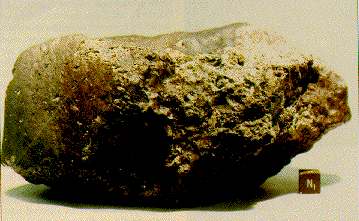
Then it was sealed in a sanitized bag, and filed away along with other meteors, on the 2nd floor of the space center, and forgotten. Almost 6 years would pass before it true identity and the secrets its held, would begin to be discovered. The first indication this meteor was unusual was in 1990, when Duck Mittlefehldt analyzed a small chip with an electron microprobe. The signature of the x-rays ricochet off the meteor indicated it was similar other meteors known as SNCs. SNC is an acronym for three meteors believed to have originated on Mars: the Sherotty, Nakhla and Chassigny. ALH would become the 10th SNC. Donald Bogard and his colleagues, examined the meteor to help determine its origin. They studied the chemical composition of gasses inside black beads of glass-like material that had bubbled up when the rock was ejected by a violent shock. The gasses matched the Martian atmosphere perfectly as measured by the Viking space craft which sampled the atmosphere in 1976. By measuring the effects of high energy cosmic rays which impacted the rock while it was in space they deduced it must have orbited in space for 16 million years. Further, by analyzing radioactive decay they estimated it must have sat in the Antarctic ice for 13 million years. Various dates have been given for the rock, based on an analysis of radioactive decay. Moreover, ALH 84001 displayed magnetic properties, ALH 84001 is a cataclastic orthopyroxenite. It initially crystallized at ~4.5 Ga and was involved in a major impact event at 4.0 Gyr that reset the Ar/Ar clock. It was expelled from the Martian surface by another meteor strike at approximately 15 Ma and eventually landed in Antarctica some 13,000 years ago. Apparently it was created between 4.5 to 3,8 billion years ago during a time when Mars still had a magnetic field. Given its age, it is estimated that it must have originated in the heavily cratered southern half of Mars, possibly linked to the Sinus Sabaeus region that has a large impact scar formed around 4 billion years ago.
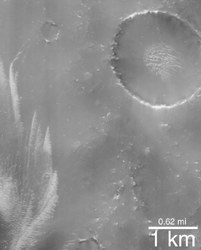
Sinus Sabaeus Mars CARBON COMPOUNDS & CARBONATE GLOBULES: SIGNS OF LIFE Mittlefehldt soon discovered the martian rock contained high concentrations of carbon compounds. He also observed rounded carbonate globs and spheroids inside the fractured surface which were visible to the naked eye. It was determined that these globules and elongated spheroids had been recycled through water, and were likely biologically produced. Carbonates are typically produced by creatures who live in the ocean, and are found in fossil beds of dead sea life.
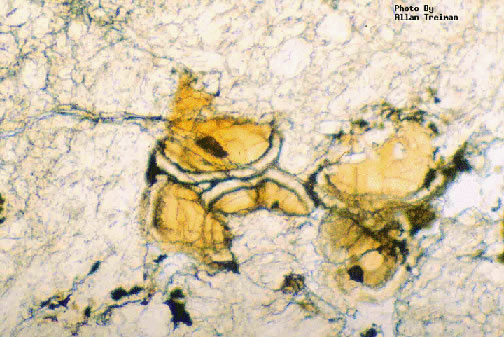
Carbonate Globules ALH 84001 Thus, the Martian carbonate minerals and carbonate globules were most likely formed by Martian microbes when Martian water seeped into the cracks when this rock was still part of Mars. The carbonate residues were formed in water, and where there is water, there is life.
Carbonate Globules ALH 84001 The Martian carbonate globules, were also discovered to contain calcium rich cores coupled with dissolved carbonates and magnetite and iron-sulfides -which were likely produced via biological processes (McKay et al. 1996); i.e. carbonate and iron-eating bacteria. The outer rims were also oxidized in a pattern that indicated biological activity; that is rusting and reducing.
Carbonate Globules ALH 84001 Everett Gibson and Christ Romanek, alerted by Mittlefehldt, studied the rock and found the carbonates had formed within temperatures habitable to life. Thus the carbonates had formed in water when temperature on Mars could support life. NANO-BACTERIA MICROFOSSILS Borrowing a technique from Robert Folk who had discovered nano-bacteria on Earth (which range in size from 50 to 100 nanometers) Romanek used acid to etch away some of the rocky material and immediately spied forms which looked like nano-fossils. The nanofossils looked basically identical to those discovered by Falk. MAGNETITE - MAGNETIC CRYSTALS Kathie Thomas-Keprta began examining the rock and found magnetic crystals. These crystals are typically created by water-living bacteria who use them for navigation. These crystals act like magnetic compasses; the magnetic properties coming from the magnetized iron. The magnetic crystals in the martian rock looked just like those created by water living bacteria. 
Magnetic Crystals: bacterial magnetosomes
Magnetite crystals from within the carbonate globules of ALH 84001 (Left), look nearly identical to magnetites formed by Earthly magnetotactic bacteria designated MV-1 (Right) Moreover, the magnetite particles were determined to be similar chemically, morphologically, and structurally to magneto-fossils (McKay et al. 1996); i.e. the fossil remains of bacterial magnetosomes, including those found in fresh pond water. These crystals were well-organized, elongated and free of defects--which on Earth are considered as indisputable evidence of biological activity. Crystals which are non-biological have chaotic defects and are filled with impurities. This was not the case for those inside the Martian meteorite. Microbes wall of a space inside their cell where they engage in the synthesis and creation of these crystals. Thus these crystals are small enough to fit inside the cell, but large enough to hold a charge. Microbes also align their crystals into chains, so that the entire chain acts like a huge magnet. This is exactly how those in the Martian meteor were organized. Using an electronic microscope, E. Imre Friedmann, FSU, in PNAS 2001, examined the Martian rock and round the telltale "choo choo train" formations characteristic of those produced by Earthly bacteria. They were lined up like a string of pearls--like vertebra running up the back, and all were similar in size and shape and did not touch each other, meaning they were flexible and allowed the organism to move. Their purpose could only be to enable their owners to navigate by reacting to a Martian magnetic field. Mars had a very powerful magnetic field for the first 800 million years after the planet began to form.

(Top) Chain of magnetite crystals produced by Earthly magnetotactic bacteria (Bottom) Magnetite crystal chains discovered in the Martian meteorite ALH 84001 Subsequently Thomas-Keprta determined that 28% of the 100s of crystal grains in the rock, were identical to those produced by earth bacteria. She called these crystals: Martian "magneto-fossils. As reported in PNAS, "unless there is an unknown and unexplained inorganic process on Mars that is conspicuously absent on the EArth and forms truncated hexa-octahendral magnetites, we suggest these magnetic crystals in the Martian meteorites ALH84001, were likely produced by a biogenic process. As such, these crystals are interpreted as martian magnetofossils and constitute evidence of the oldest life yet found."
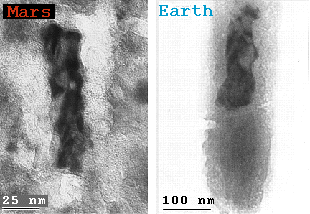
(Left) Small grains of magnetite (iron oxide) and two types of iron sulfide encase a Martian bacteria discovered in the Martian meteorite ALH 84001. These are of the same shape and size as the magnetite and iron sulfide grains formed by Earthly bacteria which live inside these grains (Right). The meteor, however, also contained numerous other signs of past Martian life. POLYCYCLIC AROMATIC HYDROCARBONS Simon Clemmet at the Zare labs used a laser mass spectrometer to probe the martian rock. The laser beam, was directed at specific molecular targets which were heated to it about 100 million degrees for one 10th of a millionths of a second. Then the target was struck with a ultraviolet laser beam. By measuring the speed of flight and changes of positively charged molecules striking a negatively charged plate, the mass and identity of these molecules was determined. The result was the positive discovery of Organic molecules called polycyclic aromatic hydrocarbons (PAHs) (with a carbon-hydrogen bond). PAHs are formed by biological processes and are the byproduct of cellular decay. PAHs are formed when bacteria die and begin to decompose. These PAHs, however, were not form Earth, but from Mars. On Earth, PAHs are typically found in fossil molecules, and are derived from biological activity associated with plankton and early plant life. Although PAHs can be formed at very high temperatures from burnt tobacco or petroleum exhaust, these are also biological substances. However, the Martian PAHs were different than those found in Earth's atmosphere and are unlike 99% of all PAHs found on this planet . They were also discovered inside but not on or near the outside of the meteor, which rules out contamination. Moreover,r the PAHS were found adjacent to the carbonate globules which were also biological in origin. Moreover, the PAHs were found in association with the the outer rims of the carbonate globules were oxidized in a pattern that indicated biological activity.

In fact, the highest concentration of PAHs were found in association with those portions of the meteorite rich in carbonates, and were determined to be indigenous. No evidence of laboratory or Earthly contamination was detected (McKay et al. 1996). Thus, it could be assumed that the Martian PAHs may have also been produced by microbes, bacteria, or even plankton and plants; which is not inconceivable as the red planet was awash with Martian oceans and great seas t the time the PAHs were formed. If due to contamination the PAHs should be most abundant on the surface of the meteor but it was not. There was little on the surface and increased in concentration as they penetrated into the interior, and the most was fund next to the carbonate globules, where it was concentrated, and in the same areas where the magnetic crystals were also the most abundant. In response to concerns about Earthly contamination, Richard Zare responded: "On the contamination issue we studied micrometeorites from the same meltwater in Antarctica and found a different pattern than we did in the Martian meteorite, and I don't see how contamination could look so different in two meteorites from the same area." Likewise, Simon Clement (1998) has independently reported that he found no evidence of terrestrial contamination and concluded that the PAHs are extra-terrestrial in origin. The PAHs were produced by Martians. When these creatures died they left PAHs. However, they also left the mineralized fossils of their bodies. MARTIAN MICROBES
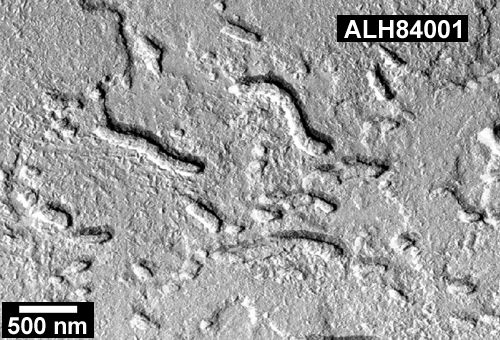
In 1996, this team of NASA scientists, headed by Dr. David McKay reported the discovery of fossilized bacteria in this 4 pound 4 billion year old Martian Meteorite. Using technologically advanced high- resolution scanning electron microscopy and laser mass spectrometry NASA scientists discovered clusters of microbes which had all the characteristics of bacteria, including those which were egg-shaped, globular, and tubular, some with the appearance of segmentation suggestive of a head and a tail. These Martian microbes lived and died in large colonies in a watery environment, and were fossilized alongside and within organic residue typically produced by bacteria. Many were strikingly similar to iron-eating bacteria and microscopic fossils of the tiniest bacteria found on Earth, called nanobacteria. However, and of equal importance, the fossilized bacteria discovered in the Martian meteor are not associated with frigid climates. All the microfossils were in fact found within and not on the surface of the meteor. The only bacteria similar to the Martian bacteria are found in salt deposits and in iron ore deep beneath the Earth. Therefore it is not reasonable to assume the fossils of Martian bacteria are due to contamination as the meteorite was found in Antarctica.
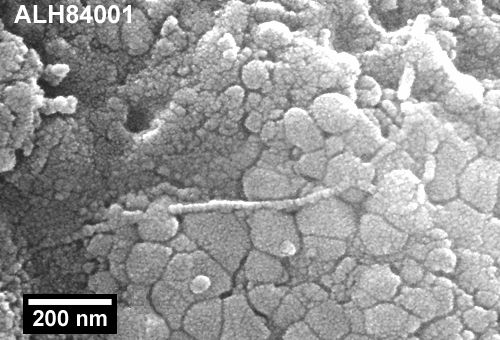
It was also determined that these Martian carbonate ovoid fossils were similar in shape and size to nanobacteria, whereas the elongated forms resemble fossilized filamentous bacteria. Further study, in fact, revealed the presence of long, segmented microfossils (McKay et al. 1996), i.e., microtubules. Moreover, it was discovered that the shape, size and other features of the ALH84001 microfossils were nearly identical to Earthly microbes, and were "remarkably similar in size and morphology to mineralized filaments and appendages from the Columbia River samples."
Martian microbes (Left) compared to Earthly microbes from the Columbia River As summarized by McKay, "Our favored interpretation is that these are in fact microfossils from Mars."

The magnetite (M) is found in topotactic association with carbonate and was evidently formed by decomposition of siderite. Both M, and Mg-rich carbonate periclase (P) are formed in association with microbial life. As noted, the fossils were found in association with microscopic oxygen and iron mineral grains, called magnetite, and alongside the carbonate globules and iron and sulphur grains, and the PAHS. These minerals are only found together when they are created biologically and are identical to those produced by bacteria. In fact, 25% of the magnetite in ALH 84001 occurs only in association with the biologic activity. They are a byproduct of iron-eating hyperthermophiles who metabolize and convert iron oxide to magnetite. Thus, the evidence is conclusive. These creatures lived and died on Mars, over 4 billion years ago. They lived at the same time life was appearing on Earth, and during an age when both planets were being pounded by asteroids, meteors, and oceans of frozen ice.
MARTIAN METEORITES NAKHLA AND SHERGOTTY On March 19, 1999, David McKay announced at the Lunar and Planetary Science Conference in Houston, that an additional pair of Martian meteorites contained "true micro-fossils from Mars." The fossils actually resembled Earth bacteria in the process of reproducing. These "micro-fossils were found in a 1.3 billion year old Martian meteorite which fell to Earth near Nakhla, Egypt, and nanofossils were found in a 165 million-year old Martian meteorite that fell near Shergotty, India.

Globular microbes discovered in Martian Meteor Nakhla
MARTIAN METEORITE EETA 79001 On October 31, 1996, British scientists and planetary geochemists, Colin Pillinger, Ian Wright, and Monica Grady, announced that they too had discovered evidence that life once existed and thrived on the red planet -Martian life that flourished as recently as 600,000 years ago. The British team analyzed two different Martian meteorites, including the fist sized rock scrutinized by NASA scientists. Specifically, they discovered a variety of organic compounds including complex organic molecules produced by and associated with carbon-based life forms in a chunk of Mars (EETA 79001) that had been blasted out some 600,000 years ago. By analyzing the various atomic weights of these chemical substances, the British team also reported that the ratios discovered match those of the oldest fossils and bacteria found on Earth; e.g. archaebacteria. Moreover, these scientists discovered "microbially produced methane" similar to the methane produced by bacteria known to live in cow guts as well as other locals on Earth. That is, they discovered chemical residue reminiscent and suggestive of cow flatulence! Farting cows on Mars? Thus there is evidence that Living creatures have populated Mars for much of its history, from 4 billion years until 600,000 years ago. Indeed, there is considerable evidence that life may still be present on Mars. In a presentation in London at the Royal Society, the British team reported that "geologically speaking, there appears to be a good chance that life might still exist in protected areas on our nearest planetary neighbor."
IS THERE STILL LIFE ON MARS Because of the low temperatures, and lack of sufficient atmospheric shielding, water on the surface of Mars will either freeze, or boil off and turn to vapor. And yet, incredible amounts of water is frozen in the permafrost. On 2008 NASA’s Phoenix Mars Lander touched down north of the Martian arctic circle. and beamed back evidence of freeze-thaw cycles in what proved to be frozen water within a couple inches of the top of the soil. Soon snow was sensed falling from the Martian clouds, and its camera captured images of hoarfrost. It also detected perchlorate, an energy source used by some Earthly microbes.

Evaporating ice on Mars over a 4 day period On earth innumerable species live within the permafrost, and even miles beneath frozen ice. Some are active. Yet others are dormant and awaken from their icy slumber when the ice begins to thaw. Similar conditions favorable to biology are also present on Mars. Because of seasonal changes in the tilt of the planet’s axis and its elliptical orbit, which brings it periodically closer to the sun, Mars’s poles warm dramatically releasing water which flows across the surface. Likewise, when exposed to sunlight, Martian rocks and soil are sometimes heated above freezing and water leaks onto the surface. VIKING SPACE CRAFT DISCOVERS LIFE ON MARS Unfortunately, the rovers and the Phoenix were not designed to test for the presence of life. Nevertheless, evidence for life on Mars was discovered in 1976, though for reasons that are not at all clear, NASA issued conflicting reports about the findings. Part of the problem was due to the fact that the two Viking space craft were sent NOT to where life may exist, but to those regions of Mars the least likely to contain life. The exploration sites were chosen for safety and not science. In addition, the equipment and experiments conducted by the Viking landers were not designed or calibrated properly, and were not sufficiently sensitive to detect the presence of microbes which might be living in permafrost or frozen tundra. Yet, even with these limitations, biological activity associated with microbial activity including reproduction, was in fact detected. Specifically, the "Labeled Release" (LR) experiment took a sample of Martian soil and added a nutrient that contained radioactive carbon. The purpose was to detect the presence of radioactivity in the gasses released that would indicate biological activity. A control experiment treated a second sample that had been sterilized. In every experiment conducted, positive results were obtained from the unsterilized sample, and negative results were obtained for the sterilized sample. Thus,the LR experiment proved there was life on Mars. However, a second series of experiments, employing a gas chromotagraph and mass spectometer was conducted to test for organic material associated with living organisms. Yet this experiment was so poorly designed and so insensitive that it would have been unable to find evidence of life on Earth under similar conditions. The GC/MS experiment required that a gram of soil had to contain over 100 million organisms before signs of life could be detected. When the GC/MS experiment was tested against Antarctic soil which was brimming with bacteria, it failed to find evidence of life. Thus, whereas the LR experiment demonstrated the presence of life on Mars, not surprisingly, the GC/MS provided negative results. NASA administrators, however, overruled the scientists who designed the experiments, ignored the positive findings and issued a statement falsely claiming that no evidence of life was found he in fact evidence of life was present. METHANE MICROBES ON MARS? A variety of life forms and innumerable microbes could easily flourish on Mars, some living in the permafrost, just inches beneath the soil, others hundreds of feet beneath the surface. The dominant life forms are probably extremophiles, microorganisms which obtain energy from minerals, metals or the reduction of carbon dioxide. Those who digest carbon dioxide or who feast on other organics would in turn release various gasses including methane as a waste product which would accumulate in the atmosphere only to bleed away into space. In fact, gasses released from within the soil are indicative of a huge biomass of Martian microbes. In 2003, huge plumes of methane gas were detected in the Martian atmosphere. On Earth, methane is generally produced biologically, by living and decaying organisms. The Methane was detected by Michael Mumma of the Goddard Space Flight Center who employed infrared spectrometers on three Earth-based telescopes, About 19,000 metric tons of methane were detected in these plumes. Beginning in 2003, Europe's Mars Express spacecraft tracked three separate methane plumes. Several possible emission sources were identified in the northern and southern hemispheres, in the vicinity of Arabia Terra, Nili Fossae and Syrtis Major. On Earth, 90% of all methane released into the atmosphere is produced biologically. Methane is released as a waste product by bacteria and burping, farting cows. Other Earthly sources include termites, decay in anaerobic paddy fields, peat bogs and landfill. The other 10% is produced geologically, such as via the interactions of water with molten lava belched out by volcanoes. Even so, only minute concentration of methane exist in the Earth's atmosphere. It is highly unlikely, in fact, it is improbable that the Martian methane plumes were produced by a non-biological sources. On earth, because of geological phenomena such as plate tectonics, and volcanic activity, various gases are continually burped into the atmosphere. On Mars, whatever seeps into the soil, rock, or which comes to be locked beneath the surface of the planet, remains locked in place. However, microorganisms would actively secrete and excrete methane, which would leak out from the surface and into the atmosphere. Thus microbes are most likely the source for methane which is constantly being replenished.
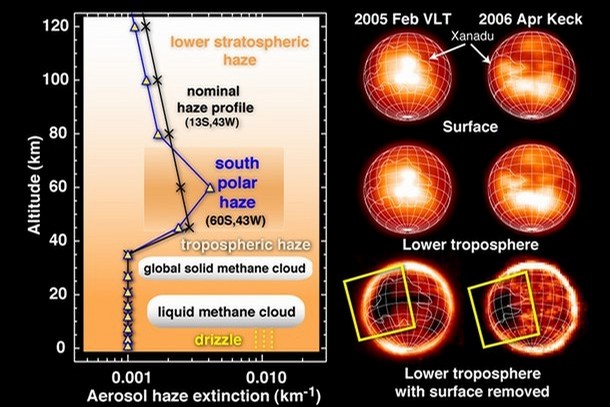
Titan. Widespread cloud cover of frozen methane (lower R). Dark area indicate seas of liquid methane. The chart on the left track's Titan's methane aerosol haze by altitude, showing the heights of frozen and liquid methane clouds. Liquid methane rains down in the mornings. The bright region named Xanadu, is awash with Methane Images were taken in 2005 and 2006. Saturn's largest moon, Titan, is also awash with methane. Rivers of liquid methane flow across the surface and there is widespread clouds of frozen methane, suggesting that it rains methane on Titan. If the source is biological or geological, is unknown. On Mars methane is readily destroyed by chemical reactions or leaks into space due to the solar wind, the lack of a magnetosphere, and the sun's UV rays. Thus, the fact that methane has been repeatedly detected, even at very low levels, indicates a living source must be continually excreting this gas. Further, because of seasonal changes in the tilt and orbit of Mars, it would be expected that biological activity would be cyclic, and thus the amount of methane released should wax and wane over time. Between 2003 and 2006, the size of the methane plumes decreased in size and extent. Although fluctuations in biological activity is a reasonable explanation, it is possible that temperature changes also associated with alterations it the tilt and orbit of Mars, trigger the opening and closing of cracks in the surface which effects venting from the planet's interior. Likewise, these same temperature changes could cause various microorganisms to be released from their icy cocoons and to begin digesting and secreting methane upon awakening. However, if the methane is being produced by living organisms, there should be evidence of other complex organic molecules in the atmosphere, and so far these have not been discovered.
CONCLUSION: LIFE ON MARS Mars was once awash with water, lakes, rivers, streams, and oceans; and like the oceans of Earth, much of Martian water must have also come from space. And where there is water there is life. In fact, there is still evidence of water on Mars, including frozen ice at the poles, and what appears to be shallow pools of water on the surface. What became of the oceans of Mars, is still a mystery. Nevertheless, 4 billion years ago and perhaps as recently as a few hundreds of thousands of years ago, Mars may have been lush with life, and evidence of past life and the oceans of Mars, can still be foundon the surface. The evidence is compelling, and includes data and/or microfossils recovered from 4 Martian meteors. These meteors are all presumed to be from Mars and to have originated on Mars based on measurement of gases trapped in one meteorite's interior. The trapped gases match those measured in the martian atmosphere by the Viking Space Craft in 1976. However, this finding assumes that the Martian atmosphere has not changed in billions of years. Based on overwhelming evidence, it can be concluded that living creatures dwelled on Mars beginning 4 billion years ago, at about the same time life appeared on Earth. Some of these Martian microbes lived in a watery environment. Others dwelled within rocks deep beneath the soil and bathed in water which seeped down into cracks within the rocks. Those microbes which died were fossilized when the water mixed with organic residue, creating carbonate cocoons which imprisoned their remains. However, when pieces of Mars were sheared from the surface and flung into space, this debris probably carried not just fossilized remains, but huge colonies of creatures that had not yet died--some of which fell to Earth. However, this does not mean that life on Earth came from Mars, or life on Mars is from the Earth. In two scholarly, scientific monographs available on the Cosmology.net website, overwhelming evidence is presented detailing the origins and evolution of life including the origin of this solar system. Life on Mars and Life on Earth, like our solar system, ultimately have the same source: a titanic parent star and its planets which were destroyed in a supernova nearly 5 billion years ago. The ancestry of Earthly and Martian Life can be traced to creatures that arrived from space, encased in all types of debris which in turn had come from other, more ancient worlds. Life on Mars, came from other planets.
|
|
|
|
|
|
|
|
|
|
|
|
|
| The Oceans, Lakes, & Rivers of the Red Planet
Resumption of Martian ExplorationAfter a 20-year hiatus in Mars exploration, the quest for onsite information about our red neighbor has resumed. First up was a launch in 1993, of the Mars Observer, a billion-dollar spacecraft, which, regrettably, failed enroute. The Mars Global Surveyor (MGS) followed on November 7, 1996, with its operation directed by JPL. The spacecraft arrived for orbital insertion on September 12, 1997. In December of 1996 the Pathfinder mission was underway, to land a roving vehicle capable of viewing the local terrain and making sophisticated measurements. An orbiting spacecraft, whose task is mainly climatic measurements, was launched in mid-December of 1998.  From an initial orbital altitude of 400 km (249 mi), the Global Surveyor used the aerobraking technique, which involved progressive slowing through air friction (drag) with the thin atmosphere, until, after six months, the spacecraft lowered to 110 km (68 mi). From there, using thrusters to maintain this altitude, a mapping mission began in late-March of 1998 to last a minimum of 687 Earth days. A second lowering was executed in 1999. The Mars Global Surveyor has a wide- and narrow-angle camera system (MOC or Mars Orbiting Camera; see next page), a Thermal Emission Spectrometer (TES), a Laser Altimeter (MOLA), a Magnetometer/Electron Reflectometer, and two other instruments. Among the first surface images, taken from the higher altitude in early October of 1997, are these two examples of the many views from the mission. The left image (175 km; 108 miles) is of a section of Labyrinthus Noctus, a maze of interlocking grabens. The right image is 12 by 12 km; it shows a canyon wall in an unidentified area of Mars.   This next image is not a computer-generated perspective of the bottom (or right) image above, but was taken from MGS when its MOC was tilted 25° towards the horizon so that the view of the canyon walls is an actual scene with a 12 meter resolution, even though the target view is 1600 km (1000 miles) away.  The Mars Orbiter Camera (MOC) can
take pictures with resolutions as good as 3 m (9.8 ft). This resolution will improve
slightly over time, as the orbital height lessens, because of the aerobraking
effect.
The next view (supplied at the MSSS web site), taken after the orbit was lowered to the altitude chosen
for the first major scientific measurements, shows details of the terrain
surrounding an elongated volcanic caldera, 2 km in length in the Tempe-Marcotis
Fossae region. Almost touching it is a round crater that may be impact in
origin. The surface surrounding these two features is marked by small dunelike
features probably built up by wind action For life to have ever existed on Mars, the best environment to expect evidence or trace of primitive life forms would be sedimentary rocks, primarily in layers, which would suggest some type of water action (although layering from volcanism or from wind deposition of loose surficial grains could also produce depositional layers). MGS's MOC has been especially valuable in imaging layering of the bedrock of Mars (presumably either lake sediments or dust beds or
volcanic flows) that has been found at many martian locations.
 The next pair of images present solid visual evidence for what appears to be significant stratification of bedrock units. The scene just below is so striking - almost artificial - that one might believe it to be a hoax. But cross-checking on the Internet verified its authenticity; it was imaged by the HiRISE camera on the Mars Reconnaissance Orbiter. The hills shown with inclined layers are in the Arabia Terra region of Mars. A close-up of the layers appears below the perspective view:   Many Mars investigators, including Dr. Michael Malin, assert views such as above as unequivocal indications for depositional layering from an aqueous medium such as water. Examine this view (MSSS) of another part of Candor Chasma: The layers can be expressed in offset ledges, referred to as "stairs-and-mounts", as exemplified here:  The Valles Marineris canyon and trough system is very well suited to the recognition and characterization of thick sequences of martian layering because, like the Grand Canyon of Arizona, it has cut so deeply into the upper martian crust. Thick layers are especially well-exposed in the tributary canyons of Valles Marineris:
Layering can show cross-bedding even when viewed from above, as evident in this example from a Mars Reconnaissance Orbiter (MRO) image of a Valles Marineris tributary valley:  High resolution MRO images are providing new details about martian layering:
Here is another example from MGS MOC imagery, showing both (presumed sedimentary) layering and linear features that are likely dune deposits, here in the walls of Melas Chasma, a tributary canyon to Valles Marineris:  Note that the so-called layers are arranged stepwise in terrace or benchlike patterns in part of the image. Such offset "layering", if this it be, is sometimes found associated with mesas in the horizontal rocks of the Colorado Plateau. In the butte-like prominence at the center right of the image, the layers are well exposed along the steep sides. Two more MOC examples further support the presumption that this layering is sedimentary in nature; the precise mode of deposition is still being debated, with two favored choices being either lake beds or volcanic ash deposits from cyclic eruptions. They show layering in the wall and the floor of Becquerel Crater in West Terra Arabia:   Units that are almost certainly layers have been exposed in craters located in the West Arabia Terra as seen in these MOC images. The top image shows layers that appear to have filled an earlier-formed crater. The layers have since been partially sculpted out as an erosional depression has formed.
In rare instances, the layers can show visible offsets, indicating faulting occurs within them. This image of layers in an impact crater in Arabia Terra reveals subtle but detectable fault lines: In the color images below showing part of a larger crater in West Arabia Terra, the layers appear inclined or dipping; but in an image from the crater center they look more horizontal, as expected if an impact crater hits on a sequence of non-inclined beds, with the dips then caused by the cratering action (on Earth craters [e.g., Meteor Crater in Arizona] in horizontal bedrock will show strongly inclined and even overturned layers outward towards the rim). The left image is near the rim top. The right image is further down the crater walls and contains black deposits which could be shock-melted rock or black basalt sand brought in by the wind.
Eroded terrain, with horizontal beds, very similar to the WTA crater has been imaged by MOC in the floor of West Candor Chasma, as seen in this black and white image: One of the largest features on Mars is the Hellas Basin. It too contains areas where prominent layering is observed, as at Aeull Valley, shown here: As seen from the above images, direct visual signs of layering are widespread on Mars. Some is caused by deposition of dust/fine sand layers in annual ice deposits in the polar regions, and is therefore presumed young. However, much older layers of varied nature - mainly basalt and sedimentary lake-or-ocean deposits - occur over wide areas of the martian terrains. In the MOC image below, layers are standing on end - nearly vertical - within the Oudemans crater near Valles Marineris. In appearance these look similar to those found at the MERS Opportunity Meridiani site (page 19-13b) and are probably sedimentary units that were shoved up in the central peak that developed during the actual cratering. An area in the Meridiani region is interesting because the light sedimentary units are topped by a dark unit (basalt?) which is now partially removed. The general setting is shown first; below it the light units are displayed in an enlargement to show the ripple and polygon features that may be primary sedimentary structures: The MOC onboard the Mars Global Surveyor has been returning some provocative high resolution images that, after much interpretive debating, many geoscientists now believe offers supporting evidence of either water escape in the recent past or even indications of water still emerging. This MOC view below (5 m resolution) indicates channels coming from material in or below the edge of the southern ice cap. The stream outflow, if that is a valid identification, in each rill ends up with a small fan of deposits at its terminus - again, a feature consistent with fluid transport. Gullies, or rills, also are noted in the walls of large craters, such as seen below. These may be caused by extended outflow of warmed subsurface ice which upon melting flows out at the walls. Other examples (second image) are considered by some to be streaks of dust avalanches, in which surface dust is mobilized, perhaps aided by water flow: This Mars Global Surveyor image shows something unusual - what appears on the right to be a wedge of frozen ice cascading downslope. This has been interpreted to indicate that water moves at shallow subsurface depths and here extrudes at a canyon wall where is freezes (much like the ice sheets seen in roadcuts during winter). If so, this further supports the argument that the rills or gullies also seen in this image are water-generated. A MGS MOC image analysis team has accumulated visual evidence that some active process - the best "guess" favors running water - is taking place today on Mars. Before-and-after images show light-toned deposits along gullied crater walls that were definitely not there on the earlier date: A color view of the Centauri Montes crater deposit indicates that it is much like similar deposits caused by water on Earth: Early surmise held these deposits to have formed by release of liquid water. However, modeling has shown a much likelier explanation is formation by landslides that release dry powdered soil whose tone is less dark than the thin surface layer. Water seems to exist on Mars in four plausible settings: 1) in small amounts in the atmosphere; 2) in polar ice caps; 3) in subsurface ice; and 4) as yet unproved, liquid water probably derived from melting of that ice along crater walls; even if so released, this water does not survive long in the fluid state but evaporates and/or freezes.  The next three images (NASA JPL and Malin Space Science Systems [MSSS]) demonstrate how planetary geologists go about interpreting and reasoning to conclusions using imagery returned from martian satellites and probes. The argument to be devised uses Martian Global Surveyor data to examine the region illustrated in this topographic map:  The Cerberus Fossa (channel) includes this 100 m wide, 10 m deep straight feature that, by comparison to similar areas on Mars, is almost certainly a tectonic graben, bounded by faults on either side expressed as steep walls. Emanating from the upper wall is what appears to be lava flows spread over both the flat land beyond the fault and into the graben floor.  Water is presumed to have excaped from the Cerberus Fossa during, or at different times from, periods of volcanic activity. The amount of water needed to develop the valley is estimated to be about that found in Lake Erie today. Based on crater counts and other data, geologists believe that the principal valley-forming events may be as recent as 10 million years ago. The Athabasca Valles extends southwest of the Fossa. It resembles a stream-cut valley similar to some on Earth. Within it is strong evidence of stream flow in the form of the streamlined, tear-drop shaped flatlands within it (see above on this page), such as shown here:  The Ma'adim Vallis (white arrow) is a 2.1 km (6900 ft) deep cut into the Southern Highlands that runs from a topographically lower area to the Gusev crater (see illustration on previous page). H. Irwin III, G. Franz of the National Air and Space Museum (NASM) and others have published evidence that the low area was once filled with water in several lakes whose extent, if on Earth, would extend across Texas and New Mexico. Their starting point is the low dark areas present in the MGS MOC image of this region. Using MOLA data to determine elevations, they have reconstructed these lakes (not now existing) by coloring the topographic lows blue against a color image of the region:   In their model, at some stage in Mars' past, the water from the central lake burst from its confines and rushed through the already forming valley, thus deepening it rapidly (analogous to the Scablands of the State of Washington; see page 17-4). A new line of evidence for water and/or ice on Mars has come from MGS images of what is considered to be analogs to phreatomagmatic "rootless" volcanoes on Earth (especially in Iceland). Consider this image (MSSS) of a swarm of cones in the Cerberus Plains near the martian equator:  The origin of these miniature cones (typically, about 50 meters at their base) requires water to have been released at earlier times that becomes trapped near the surface (perhaps at depths of 3-5 meters). At the cold martian temperatures, this water is preserved as ice. Then, later eruption(s) of volcanic flows heat the water to steam, causing a pressure buildup that ejects material locally to build up the cones. The implication of the presence of these cones on what may be a young surface is that ice entrapment may occur within suitable martian terrains and could thus be available as a source of water during human exploration of this planet. Some Mars scientists are arguing for the presence of water as ice and/or "snow" deposits that form both varying and persistent deposits in areas of lower latitudes. This is related to the migration of water vapor and CO2 during the changing martian seasons. Perhaps the most provocative indicator of subsurface water that outflows in non-polar regions of Mars is shown in this next illustration:  This feature has been given two interpretations: 1) it is an ice glacier (note the parallel ridges); or 2) it is a rock avalanche. Its geomorphic expression as seen from above seems better fitted to the first explanation. The Laser Altimeter (MOLA) on the Mars Global Surveyor yields
maps and profiles that show martian relief. The southern hemisphere is, on average,
10 km (6 miles) higher than the younger northern hemisphere. This is brought home by this block diagram that shows variations in topography alone the 0° latitude running from the North Pole (left) to the South Pole:
The maximum relief
on Mars ranges to 30 km (19 miles), determined by Valles Marineris as the high point and the Hellas Basin the low point, about 1.5 times greater than that on Earth. The three white round areas are the Tharsis volcanoes and the offset white one is to the left. The brown rounded area above these is Alba Patera. Valles Marineris is obvious. The blue-green circular feature below is Argyre Planitia. The large elliptical blue region
in the red southern hemisphere is a huge topographic depression about 2100 kilometers (1300 miles) wide known as the Hellas Basin.
One of the most dramatic of these
MOLA data plots presents an exaggerated profile across Olympus Mons and Arsia
Mons/Alba Patera (which is actually higher than Olympus).
Still another example of a MOLA-based topographic map is that centered on the Herschel crater east of Hesperia Planum:  The topographic map of Mars, combined with gravity and other data, allow calculation of the general thickness of the martian crust, as shown in this global map:
Thicknesses of the crust at major locations are estimated as shown in this Table: Note the fairly strong correlation between topography and thickness, emphasized here by using the same scheme of reds/orange for higher elevation/greater thickness and blues for lowest elevations/minimal thickness in the two relevant maps. Another exciting and informative
scene taken by the Global Surveyor combines a color view of the North Pole
Ice Cap with topographic data obtained from a series of Laser Altimeter passes
to produce this three-dimensional view: The size and amount of ice (which
the spectrometer confirmed was largely water ice) was less than anticipated
from pre-Surveyor observations. The cap is roughly 1,200 km (746 mi) across
(crudely circular) and as much as 3 km (1.9 mi) thick. With an average thickness
of 1 km (0.62 miles), the volume of ice is about 1.2 million cubic kilometers
(288,000 cubic miles), roughly half that of the Greenland Ice Cap on Earth.
The cap's general surface is quite smooth, but the ice cap is cut by large,
deep (up to 1 km; 3,280 ft) steep-walled canyons and troughs, which may have
come from cracks enlarged by wind and possibly meltwater. The amount of water
located today at the North Pole, and lesser quantities now at the South Pole, does
not seem sufficient to have once made an ocean over parts of Mars. It instead
may be the remnants of any seawater that could have existed in the Mars past. Any relationship of this surviving water to the river-like channels on Mars is still speculative. Water may be widespread even now but would be subsurface. Detecting that water is one of the objectives of future Mars missions. MGS's Thermal Emission Spectrometer (TES) can produce images similar to those made using visible light (as an example, check the image of Ma'adim Vallis on the previous page). Other THEMIS (longer) IR wavelengths form images which clearly differentiate hotter (whitish) from cooler (dark) surface materials. This image shows a thermal pattern in which the blackish part indicates a smooth, dust-covered surface and the light blotches represent blocks and debris in some cases associated with craters: When TES surveys the same scene during martian daylight and again at martian nighttime, the differences in tone reveal information about the thermal inertia of the materials involved. Here are two views of a martian crater. The ejecta blanket holdss more heat during the day and loses more during the night, owing to its porous nature. The surrounding rock/soil remains warmer during the night. TES can identify some individual minerals and determine in a semi-quantitative way their proportions in the surface rocks (believed to be primarily basalt and andesites). The mineral Pyroxene (an iron-magnesium silicate) occurs in rocks found in Syrtis Major. Note its variable distribution, with the largest amounts
present in the darker areas of this region. The MGS on Odyssey had an instrument capable of detecting weak magnetic fields. Earlier spacecraft suggested that one exists. MGS provided this data set shown as three maps of the field strengths in different directions:  It is still somewhat uncertain whether this is an active magnetic field (implying some surviving liquidity of the core, within which magnetic fields are generated) or is a fossil (remanent) field. Opinion currently favors the latter; there are strong negative fields associated with the Argyre and Hellas Basins, which suggests an already frozen field lost strength from the impacts that caused these two structures. If true, then the protective cover afforded by a magnetic field that captures solar wind and other radiation did not last long. But prior to that an active field would help to maintain a thicker atmosphere which in turn might have supported water vapor that could produce rain, streams, and primitive life. An April 1999 report by Mars Global Surveyor investigators has created a flurry of excitement about an aspect of the martian crust which may be a counterpart to the mobile segments of terrestrial crust that are involved in the concept of Plate Tectonics - a cornerstone in our understanding of the operation of the Earth's outer layers embodied in the idea of "continental drift". The Mars Global Surveyor magnetometer has picked out a series of magnetic stripes on Mars that systematically reverse their polarities. Thus:  As more data accumulated, a nearly complete map of magnetic strengths has been made. Again, the stripes are the most obvious feature. One interpretation is that they are related to a time in the past when Mars had some mode of plate tectonics, with crust forming, rising, and subducting.  These martian strips are found mainly in the older terrains of the Southern Hemisphere. They trend at high angles to the polar axis. The implication is that this crust was formed by outpourings of lava from analogs to the terrestrial oceanic ridges that push the plates towards subduction zones (no such features have yet been recognized on Mars nor are there changes of mountains that result above these zones). This also suggests a much stronger magnetic field during early martian times; this would indicate a (partially) molten core. The full meaning of this new discovery is yet to be assessed. Martian exploration reached a new plateau when landers allowed on site close-up inspection of martian terrain and rocks. Launched on December 4, 1996, JPL's
Pathfinder landed on July 4, 1997, in the Ares Valle near the earlier Viking
1 site . This shorter transit time (seven months) resulted from a better alignment
of Mars and Earth in their orbits. Pathfinder used a cluster of small inflated bags which, together with a parachute, cushioned the descent and deployment onto the martian surface. Here is a mock-up version of the equipment as exhibited at the National Air and Space Museum. Note the small Sojourner rover.
The primary scientific purpose of Pathfinder was to release the small Sojourner Rover, guided from Earth through the lander's communication system. The Rover moved independently (after departing the lander down a ramp) up to 20 m away on its six, flexible, rocker wheels, to take pictures and bring its spectrometer against rock surfaces for analysis. 
This microrover, which weighed 11.5 kg (25.4 lbs), measured the following: length = 630 mm (24.8 in), width = 480 mm (18.9 in), and height = 280 mm (11.0 in). Using power from a solar panel, Sojourner moved at a maximum speed of 40 mm/min (0.13 ft/min) during the martian day. Its front and back wheels moved independently to control its steering. The Rover used a stereo camera, mounted at its front, which imaged objects in its path. Each excursion was intermittent, because operators on Earth determined direction changes to reach target rocks and avoid obstacles. This took extended time periods because of the long distances radio and video signals traveled back and forth. When it encountered small rocks, the wheels raised up to glide over the obstruction. The stereo camera system on the Pathfinder took images of the surface around the lander, obtaining black and white views and colored ones with color filters. Sojourner's camera also collected images (mainly rock close-ups). In the three images below, the first shows part of the scene viewed by the camera, the second is a montage of part of the surrounding site, in which we identify (using friendly names that speak a personal touch) some of the rocks that it visited, and the third is a panorama of the 360° view around the Pathfinder (after Sojourner had departed) made by the camera mounted on the mast as it looked downward.  
 Many of the rocks are grayish on fresher surfaces. These surfaces appear weathered and pitted, and often are, at least partly, dust-covered. A typical large rock is Yogi (shown below), which appears to have a reddish dust blanket on one side and a sharp boundary with fresher rock (right side). The primary instrument on the rover is the alpha-proton-x-ray spectrometer (APXS). This instrument uses high speed alpha particles to bombard soil or rock surfaces. These particles generate a back scattering of alpha particles, alpha-proton particles, and x-rays, whose energies as determined at the detectors are indicative of a wide number of elements. It thus detects, quantitatively, elements such as those in rocks, i.e., Si, Al, Ca, Fe, Mg, K, Na, Ti, Mn, Cl, S, P, O, and C. It can report these elements in their elemental form or as oxides. The diagram below is a histogram of many of these elements from Barnacle Bill, Scooby Doo, Yogi, and some soil sites. Barnacle Bill's composition is close to that determined earlier at the Viking site but the other rocks and soils are different.
 The next graph (top), is a plot of values of elemental ratios of Fe/Si and Ca/Si from the Pathfinder site, compared with certain Earth rocks. The Mars rocks at this site are definitely not basalt. They plot closer to but not within the compositional field of the terrestrial volcanic rocks known as Andesites. When we recalculate the elemental composition of the rocks into what petrologists term normative rock compositions, we see that the mineralogy is similar to andesites (bottom diagram).   But the presence of normative quartz (leftover silica, after we assign all other SiO2 to the other minerals), technically makes this rock type a dacite. Andesites and dacites are the common volcanic rocks emitted from continental volcanoes, such as those along the Ring of Fire (e.g., the Pacific Coast Cascades). The presence of these rock types at this martian site, if typical of other sites, suggests that the Red Planet had melted and differentiated, so that at least part of its crust is andesitic. Paul Lowman (author of Section 12 of this Tutorial) had postulated more than a decade ago that an andesitic primordial crust probably developed early in Earth history and may be the norm for other inner planets. Most of the rocks plot in the basaltic and andesitic fields of a diagram which shows the classification of basic to silicic igneous (volcanic) rocks found on Earth in terms of NasO + K2O versus Sio2:  Interpretation of MGS and Pathfinder data, supplemented by that acquired later by Mars Odyssey (see below), has led to this general map of the surface rocks and sediment cover on Mars. Basalts, overall the most common of the martian surface volcanic rocks, are shown in green and yellow; andesites in blue, and regions where dust cover is so thick that data on underlying bedrock could not be recorded appear in medium tan:  Some individual volcanoes appear to produce lava outpourings of different compositions from time to time, suggesting differentiation in the magma chamber. A good example is Nili Patera, in Syrtis Major, which produces both basaltic (blue) and andesitic (red) lavas as determined from MGS data; some of the latter may actually be dacites (andesitic but with quartz); one or more small peaks within the scene may have been further enriched in silica to gain a granitic composition:  The occurrence of andesites leads to several postulates: 1) these rocks are evidence of some differentiation in the martian mantle; 2) they may represent rocks involved in subcrustal release of water; or 3) they are anomalous local thin veneers on the dominant basalts caused by surface altering processes. No definitive conclusion has been agreed upon. So far, martian Landers have gathered compositional data at five widely-separated martian sites (Pathfinder; the the two Vikings; the two MERS rovers.). In general, bedrock at the sites are similar in their chemical makeup. This may simply mean that the martian crust tends to be homogeneous, but even more likely is the explanation that martian wind circulation has scattered and homogenized compositional differences across the planet. The distribution of rocks and boulders at the Pathfinder site further supports earlier ideas that at one time in the Mars' past there was considerable water cover and resultant flow currents, causing a pattern sometimes observed on Earth as flood-related. The last Pathfinder image we show below is a classic sunset picture, taken through the thin, dusty, martian atmosphere that produced a fan-shaped glow around the distant Sun.
 |
